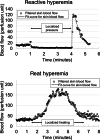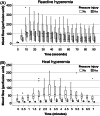Utilisation of skin blood flow as a precursor for pressure injury development in persons with acute spinal cord injury: A proof of concept
- PMID: 35543296
- PMCID: PMC9705160
- DOI: 10.1111/iwj.13829
Utilisation of skin blood flow as a precursor for pressure injury development in persons with acute spinal cord injury: A proof of concept
Abstract
People with spinal cord injury (SCI) are at high risk of developing a pressure injury. It is unclear why some people with SCI develop pressure injury while others with similar predisposing risk factors do not during acute hospitalisation. This may hinder healthcare utilisation to prevent pressure injuries. The purpose of the study was to examine the proof-of-concept objective bedside skin blood flow measurements before a pressure injury develops in spinal cord injured patients during acute hospitalisation. This was an observational study. All participants had acute traumatic SCI and were pressure injury-free upon enrollment. Skin blood flow patterns were collected at both heels under two circumstances: localised pressure for reactive hyperemia, and localised heating for heat hyperemia. Our results showed that reactive and heat hyperemia were successfully induced in all eleven participants. Two participants developed pressure injury and nine did not have pressure injury at discharge. Heat hyperemia was smaller in participants with pressure injury. No difference was observed in reactive hyperemia between the groups. In conclusion, skin blood flow measurements could be obtained at bedside during acute hospitalisation of SCI for the purpose of research. Further examination of a larger group is warranted to determine clinical use of heat hyperemia pattern as predictor for pressure injury development.
Keywords: hyperemia; microcirculation; pressure ulcer; spinal cord injuries.
© 2022 The Authors. International Wound Journal published by Medicalhelplines.com Inc (3M) and John Wiley & Sons Ltd.
Conflict of interest statement
One author of this manuscript (Wukich) has the following conflict of interest that does not involve this manuscript: serves as a consultant with Orthofix Medical Inc., Stryker and Wright Medical, and receives royalties from Arthrex Inc.
Figures



Similar articles
-
Using reactive hyperemia to assess the efficacy of local cooling on reducing sacral skin ischemia under surface pressure in people with spinal cord injury: a preliminary report.Arch Phys Med Rehabil. 2013 Oct;94(10):1982-9. doi: 10.1016/j.apmr.2013.03.022. Epub 2013 Apr 10. Arch Phys Med Rehabil. 2013. PMID: 23583346
-
Hybrid equation/agent-based model of ischemia-induced hyperemia and pressure ulcer formation predicts greater propensity to ulcerate in subjects with spinal cord injury.PLoS Comput Biol. 2013;9(5):e1003070. doi: 10.1371/journal.pcbi.1003070. Epub 2013 May 16. PLoS Comput Biol. 2013. PMID: 23696726 Free PMC article.
-
The effect of clinically relevant pressure duration on sacral skin blood flow and temperature in patients after acute spinal cord injury.Arch Phys Med Rehabil. 2007 Dec;88(12):1673-80. doi: 10.1016/j.apmr.2007.07.037. Arch Phys Med Rehabil. 2007. PMID: 18047884 Clinical Trial.
-
[Pressure ulcers after spinal cord injury].Tidsskr Nor Laegeforen. 2012 Apr 17;132(7):838-9. doi: 10.4045/tidsskr.10.0878. Tidsskr Nor Laegeforen. 2012. PMID: 22511098 Review. Norwegian.
-
Potentially modifiable risk factors among veterans with spinal cord injury hospitalized for severe pressure ulcers: a descriptive study.J Spinal Cord Med. 2012 Jul;35(4):240-50. doi: 10.1179/2045772312Y.0000000016. J Spinal Cord Med. 2012. PMID: 22925750 Free PMC article. Review.
Cited by
-
Effect of Heat Shock Preconditioning on Pressure Injury Prevention via Hsp27 Upregulation in Rat Models.Int J Mol Sci. 2022 Aug 11;23(16):8955. doi: 10.3390/ijms23168955. Int J Mol Sci. 2022. PMID: 36012220 Free PMC article.
-
Risk factors for pressure injuries in individuals with spinal cord injuries who have sarcopenic obesity: A comparison of time-dependent changes in sacral region pressure between individuals with and without sarcopenic obesity.J Spinal Cord Med. 2025 May;48(3):438-446. doi: 10.1080/10790268.2024.2379068. Epub 2024 Jul 24. J Spinal Cord Med. 2025. PMID: 39047200 Free PMC article.
References
-
- Chen Y, Devivo MJ, Jackson AB. Pressure ulcer prevalence in people with spinal cord injury: age‐period‐duration effects. Arch Phys Med Rehabil. 2005;86:1208‐1213. - PubMed
-
- European Pressure Ulcer Advisory Panel, National Pressure Injury Advisory Panel & Pan Pacific Pressure Injury Alliance . Prevention and treatment of pressure ulcers/injuries: clinical practice guideline. The international guideline. (EPUAP/NPIAP/PPPIA, 2019).
-
- Roustit M, Cracowski J‐L. Assessment of endothelial and neurovascular function in human skin microcirculation. Trends Pharmacol Sci. 2013;34:373‐384. - PubMed
-
- Cracowski J‐L, Minson CT, Salvat‐Melis M, Halliwill JR. Methodological issues in the assessment of skin microvascular endothelial function in humans. Trends Pharmacol Sci. 2006;27:503‐508. - PubMed
Publication types
MeSH terms
Grants and funding
LinkOut - more resources
Full Text Sources
Medical

